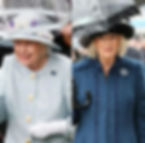Prince Albert’s Sapphire Brooch
- Victoria Regina
- Feb 9, 2024
- 4 min read
Updated: Feb 13

Prince Albert is renowned for designing pieces of jewellery as a gift for his wife, Queen Victoria. One of the first, and perhaps most famous, pieces he gave her was a ‘splendid brooch of an immense Sapphire, set round with diamonds’, which she received on the evening of 9th February 1840, the day before their wedding. Despite not wanting to get married covered in jewels or state robes, Victoria made sure to wear her ‘Angel’s beautiful sapphire brooch’ for the ceremony. This was later immortalised by Franz Xaver Winterhalter in his 1847 portrait of the Queen, which you can see pictured below.

She recorded the moment in her diary:
“My precious Albert gave me a splendid and lovely broach of an immense Sapphire, set round with diamonds; it is quite beautiful.”
Naturally, the brooch quickly became one of Victoria’s favourite pieces of jewellery and was worn for many special occasions and portraits throughout her reign. Before his premature death in 1861, Prince Albert had brooches made in a similar style for each of their five daughters. It is also thought Princess Diana's sapphire wedding ring was inspired by Queen Victoria's beautiful sapphire brooch.
Until recently it was believed to have been commissioned from Garrard by Prince Albert – indeed, Prince Albert’s ledger does record that he purchased items from Garrard, and their website also reports this story to be the case. However, recent research by historian Erik Shoonhoven has cast doubt on this. His research indicates that the brooch was actually purchased from the Dutch Court Jeweller, Josephus Jitta, by Albert’s father, Ernest I, Duke of Saxe-Coburg and Gotha.
There are correspondence detailing the sale of a jewel that exactly fits the description of Queen Victoria's Wedding Brooch, happening right after the engagement of the Queen with the Duke’s son Prince Albert was announced. A portrait from circa 1840 confirms that Queen Victoria did indeed use the brooch as a fermoir, when she wore it as the clasp of a several strand pearl necklace. In the correspondence, a second smaller (half the price of the fermoir) sapphire surrounded by brilliants is also mentioned, which could correspond with the brooch that is known to have entered the Royal Collection shortly after Queen Victoria’s wedding brooch.
A contact from the annual trade fair in Leipzig, the merchant and banking house Frege had excellent connections with German royal houses. It is through them that Wolf Jitta in October 1839 offered the Duke of Saxe-Coburg and Gotha a fermoir (a clasp, often used as brooch) containing a very large sapphire surrounded by 12 brilliants, for the asking price of 12,000 guilders. In first instance, Albrecht Friedrich Schnür of the Herzogliches Privat-Bureau, the private offices of the Duke, responds negative to the offer. But when Wolf, on his travels back to Amsterdam, decides to visit Coburg with a new offer 10,000 guilders to be paid within a year, interest in the fermoir is reignited.
On 4 January 1840 Schnür spoke with Simon about diamond set boxes. Wolf mentions being able to send them to London instead of Gotha, in time for the end of the month. This is likely an order for diamond set snuffboxes to be distributed for the wedding of Queen Victoria and Prince Albert that was to take place on February 10, 1840. 6 January 1840 Wolf sends Schnür design drawings, not only of the fermoir but also of a set 125 gram pear-shaped pearl and a set brilliant of 16 grams to be attached to the fermoir. Also on offer: a bracelet of 10 strings of first quality pearls, and a sapphire surrounded by brilliants (5,600 guilders),a ferronnière that can also be used as necklace consisting of 20 first class brilliants of which the largest weighs 6 gram, a sapphire, a brilliant and a pear-shaped pearl. Price: 5,300 guilders.

Upon Queen Victoria's death in 1901, she left the iconic brooch as a Heirloom of the Crown. Since then, it has been worn by each Queen Regnant and Queen Consort, although Queen Alexandra, Queen Mary and Queen Elizabeth (later the Queen Mother) rarely only wore it on a small number of occasions. However, the piece quickly became a firm favourite of Queen Elizabeth II upon her ascent to the throne in 1852, and went on to become one of her most worn pieces of jewellery.

The smaller version of the brooch was purchased – it was originally thought that Albert had commissioned additional versions of the brooch for his daughters, but it is believed it had been purchased from the same jeweller as the original at around the same time. This smaller brooch was believed to have been inherited by Princess Helena, and ultimately found it’s way to auction, where Queen Elizabeth II purchased it for her daughter, Princess Anne, The Princess Royal.

Since the late Queen Elizabeth II passing, Prince Albert’s brooch has once again passed to a new owner, and Queen Camilla too, has now worn this family heirloom.
© QueenVictoriaRevival 2024
This article is the intellectual property of Queen Victoria Revival and should not be COPIED, EDITED, OR POSTED IN ANY FORM ON ANOTHER WEBSITE under any circumstances unless permission is given by the author.